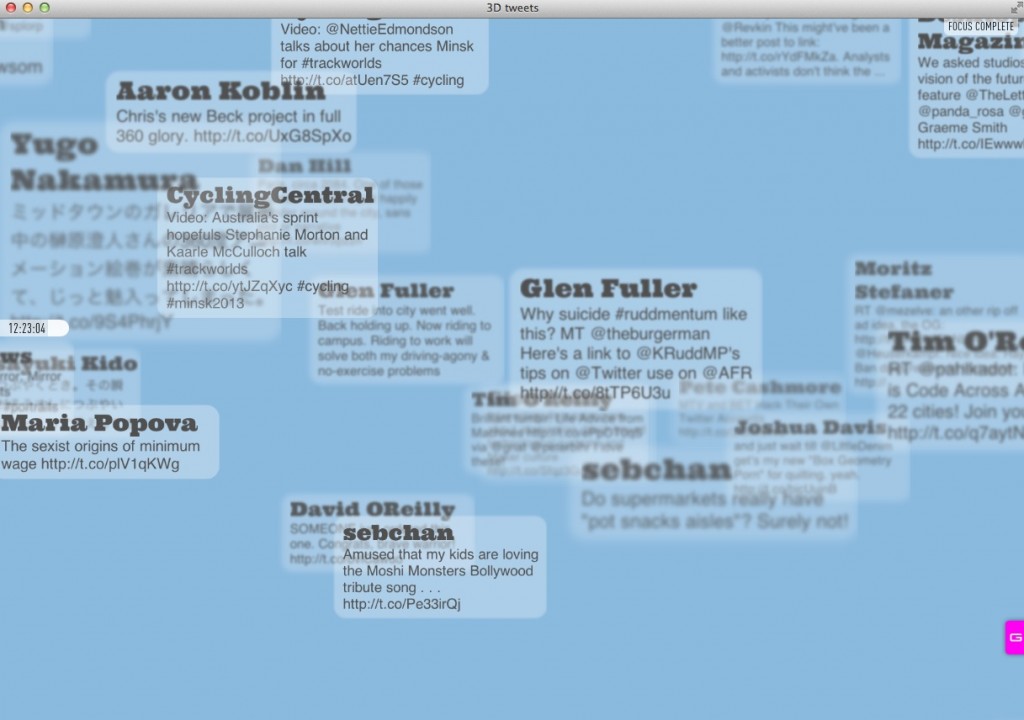Desktop Magazine interviewed Mitchell Whitelaw and myself late in 2012 for their Dec/Jan issue. The theme of the issue was “the future” and our interview addressed the future of data-graphics / data-viz. It was fun to offer some thoughts and a real privilege to appear amongst the stellar list of contributors that editor Heath Killen assembled including Dan Hill, Casey Reas, Seb Chan, Stuart Candy, and Alexandra Daisy Ginsberg, among others. Danielle Neville wrote a great opener and the issue also featured some work from Patrick Stevenson-Keating, as well as fellow Canberran Paul Krix. Now that the dust has settled on the print version, the good folks at Desktop Magazine have published our interview on their website in two parts: Part one, and Part two.
Not long after its web publication Part two prompted an unequivocal rebuttal (via Twitter) from dataviz pro Ben Hosken of Flink Labs.
Completely disagree w/ @gravitron on future of #dataviz. Problems of Simplicity should and will be in graphic design but not complexity. 1/2
— Flink Labs (@flinklabs) February 28, 2013
By Problems of Simplicity I mean 2,3,4 variables over time vs Org/Disorg’d Complexity – Weaver 1948. Tools willing, simple should be simple
— Flink Labs (@flinklabs) February 28, 2013
Terrible spot for data visualisation practitioners who don’t have strong data skills. Tableau, D3 etc. will eat their lunch.
— Flink Labs (@flinklabs) February 28, 2013
Twitter is not an ideal forum for in-depth exchange, but I believe that this was the offending statement from the interview:
Where are things headed in the immediate future for data visualisation?
GH: I predict data visualisation becoming a normal part of graphic design practice. Data viz cannot be considered a special case, something to be ignored or left to others to deal with. Data is a constant in our society and its significance is only increasing. It’ll take a bit of work for graphic designers to become completely comfortable with the practices of data representation but as they do I think we’ll see data being used more commonly and creatively – something that I look forward to.
I didn’t mean to underestimate what is involved in dataviz, particularly when dealing with large &/or complex datasets and creating dynamic interactive works (D3, Tableau, etc). My point was only that graphic designers will increasingly be expected to possess some data literacy – to have the ability to work with data and prepare engaging visual representations. The same thing happened with web design – it was initially treated as a curiosity by graphic designers and graphic design education but is today a staple of the graphic design profession and essential for graphic design graduates (IMHO). That is not to suggest that graphic design graduates need to be web dev experts, but only that they need a decent literacy in design for web. Ditto for dataviz. If nothing else, the exchange highlights the ambiguity of the term “dataviz”. It’s a huge domain with plenty of scope for contribution from a diversity of practitioners.
As well as some blue sky thinking on the future of data-graphics/viz the interview provides some context for the teaching and research that Mitchell, myself and our colleagues are conducting at the University of Canberra. If you’re interested, we have programs at all levels: Bachelors, Honours, Masters by coursework, Masters by research, and doctorate.
Links: Heath Killen interview | Flink Labs |
